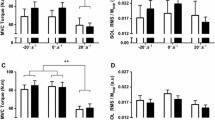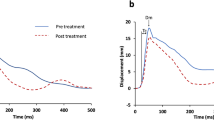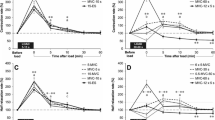Summary
To elucidate the changes in neuro-muscular function during strength training and detraining, five male subjects underwent progressive isotonic strength training of their calf muscles three times a week for 8 weeks with additional detraining for the same periods. Electrically evoked twitch contractions were induced in the triceps surae muscles of each subject every 4 weeks during the training and detraining periods. At the same time, maximal voluntary isometric contractions (MVC) and the maximal girth of the calf (MGC) were measured. During the training period, MVC increased significantly from 98.4 to 129.6 Nm (31.7%, P < 0.01) for the first 4 weeks of training but MGC showed little increase. Neither of the changes correlated with each other. Twitch contraction parameters, i.e. maximal twitch torque (P t ), maximal rate of torque development (max dT/dt) and rate of relaxation (relax dT/dt) showed no statistical change. During detraining, on the contrary, a large and significant increase (22.5%, P < 0.01) was observed in max dTldt without any changes in P t and relax dT/dt. The MVC/P t showed both significant increases during training and decreases during detraining. Our data suggest that short term strength training as employed in the present study does not induce changes in the contractile properties of the muscle during training, but may significantly affect the rate of force development during the subsequent detraining period, indicating the possible existence of complex post-training muscle adaptation.
Similar content being viewed by others
Reference
Bass A, Vondra K, Ratmir R, Vitek V, Teisinger J, Mackova E, Sprynarova S, Malkovska M (1976) Enzyme activity patterns of energy supplying metabolism in the quadriceps femoris muscle (vastus lateralis). Sedentary men and physically active men of different performance levels. Pflügers Arch Ges Physiol 361:169–173
Belanger AY, McComas AJ (1981) Extent of motor unit activation during effort. J Appl Physiol 51:1131–1135
Cooper RR (1972) Alterations during immobilization and regeneration of skeletal muscle in cats. J Bone Joint Surg 54-A:919–951
Davies CTM, Young K (1983) Effects of training at 30 and 100% maximal isometric force (MVC) on the contractile properties of the triceps surae in man. J Physiol 336:22–23
Davies J, Parker DF, Rutherford OM, Jones DA (1988) Changes in strength and cross sectional area of the elbow flexors as a result of isometric strength training. Eur J Appl Physiol 57:667–670
Dawson MJ, Gadian DG, Wilkie DR (1980) Mechanical relaxation rate and metabolism studied in fatiguing muscle by phosphorus nuclear magnetic resonance. J Physiol 299:465–484
de Vries HA, Wiswell RA, Bulbulian R, Moritani T (1981) Tranquilizer effect of exercise. Am J Phys Med 60:57–66
Duchateau J, Hainaut K (1984) Isometric or dynamic training: differential effects on mechanical properties of a human muscle. J Appl Physiol 56:296–301
Duchateau J, Hainaut K (1987) Electrical and mechanical changes in immobilized human muscle. J Appl Physiol 62:2168–2173
Fitts RH, Courtright JB, Kim DH, Witzmann FA (1982) Muscle fatigue with prolonged exercise: contractile and biochemical alterations. Am J Physiol 242:C65-C73
Guy PS, Snow DH (1977) The effect of training and detraining on muscle composition in the horse. J Physiol 269:33–51
Häkkinen K, Komi PV (1983) Electromyographic changes during strength training and detraining. Med Sci Sports Exerc 15:455–460
Häkkinen K, Komi PV (1986) Training-induced changes in neuromuscular performance under voluntary and reflex conditions. Eur J Appl Physiol 55:147–155
Houston ME, Froese EA, Valeriote P, Green HJ, Ranney DA (1983) Muscle performance, morphology and metabolic capacity during strength training and detraining: a one leg model. Eur J Appl Physiol 51:25–35
Jones DA, Rutherford OM (1987) Human muscle strength training: the effects of three different regimes and the nature of the resultant changes. J Physiol 391:1–11
Kim DH, Witzmann FA, Fitts RH (1982) Effect of disuse on sarcoplasmic reticulum in fast and slow skeletal muscle. Am J Physiol 243:C156-C160
Komi PV, Viitasalo JT, Rauramaa R, Vihko V (1978) Effect of isometric strength training on mechanical, electrical, and metabolic aspects of muscle function. Eur J Appl Physiol 40:45–55
MacDougall JD, Elder GCB, Sale DG, Moroz JR, Sutton JR (1980) Effects of strength training and immobilization on human muscle fibres. Eur J Appl Physiol 43:25–34
McDonagh MJN, Hayward CM, Davies CTM (1983) Isometric training in human elbow flexor muscles. J Bone Joint Surg 65:355–358
Milner-Brown HS, Stein RB, Lee RG (1975) Synchronization of human motor units: possible roles of exercise and supraspinal reflexes. Electroencephalogr Clin Neurophysiol 38:245–254
Moritani T, de Vries H (1979) Neural factors versus hypertrophy in the time course of muscle strength gain. Am J Phys Med 158:115–130
Moritani T, Berry MJ, Bacharach DW, Nakamura E (1987) Gas exchange parameters, muscle blood flow and electromechanical properties of the plantar flexors. Eur J Appl Physiol 56:30–37
Sale DG, McComas AJ, MacDougall JD, Upton ARM (1982) Neuromuscular adaptation in human thenar muscles following strength training and immobilization. J Appl Physiol 53:419–424
Schmidtbleicher D, Haralambie G (1981) Changes in contractile properties of muscle after strength training in man. Eur J Appl Physiol 46:221–228
Viitasalo JT, Komi PV (1981) Effects of fatigue on isometric forceand relaxation-time characteristics in human muscle. Acta Physiol Scand 111:87–95
Author information
Authors and Affiliations
Rights and permissions
About this article
Cite this article
Ishida, K., Moritani, T. & Itoh, K. Changes in voluntary and electrically induced contractions during strength training and detraining. Eur J Appl Physiol 60, 244–248 (1990). https://doi.org/10.1007/BF00379390
Accepted:
Issue Date:
DOI: https://doi.org/10.1007/BF00379390




